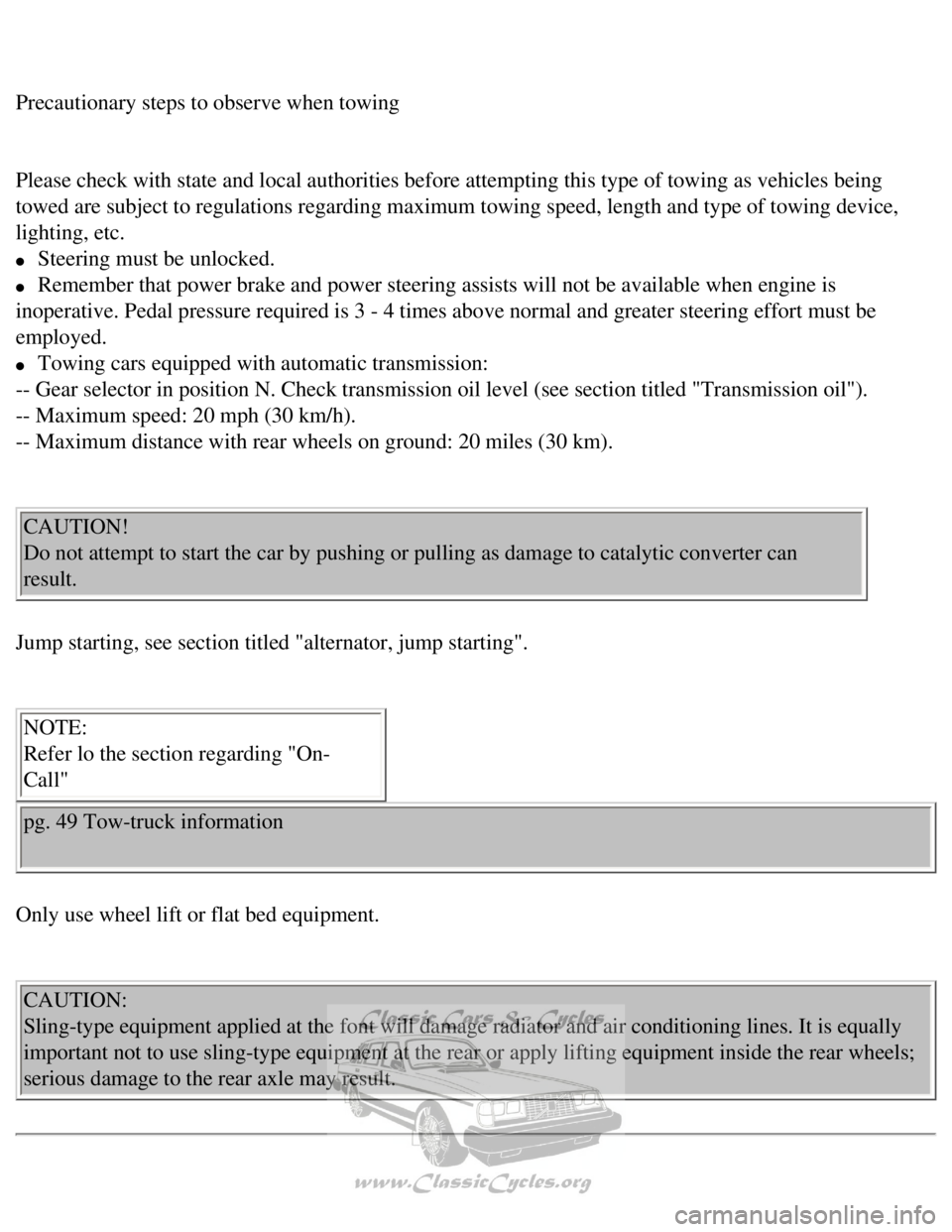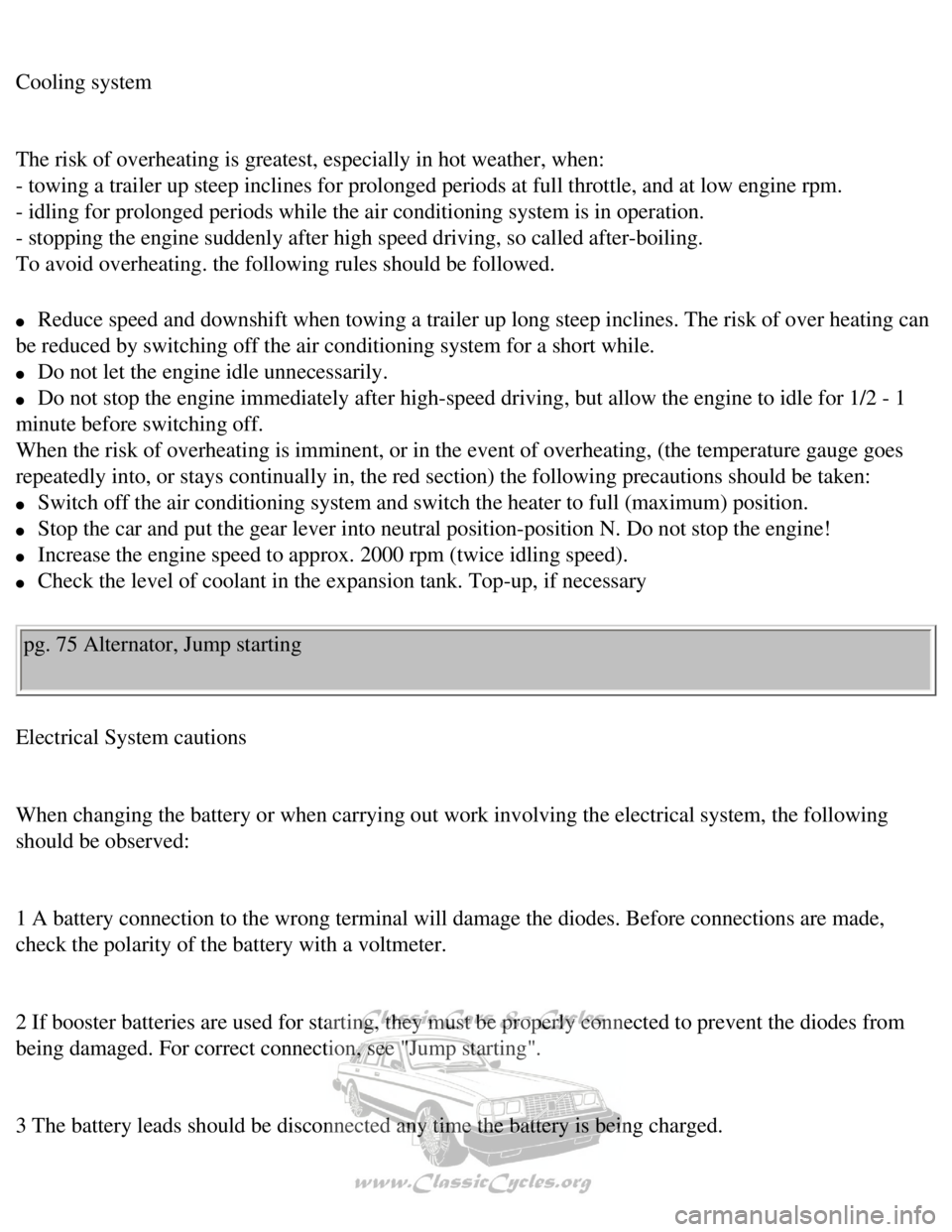Page 62 of 143

Volvo 1990 240 Model
Precautionary steps to observe when towing
Please check with state and local authorities before attempting this typ\
e of towing as vehicles being
towed are subject to regulations regarding maximum towing speed, length \
and type of towing device,
lighting, etc.
l Steering must be unlocked.
l Remember that power brake and power steering assists will not be availab\
le when engine is
inoperative. Pedal pressure required is 3 - 4 times above normal and gre\
ater steering effort must be
employed.
l Towing cars equipped with automatic transmission:
-- Gear selector in position N. Check transmission oil level (see secti\
on titled "Transmission oil").
-- Maximum speed: 20 mph (30 km/h).
-- Maximum distance with rear wheels on ground: 20 miles (30 km).
CAUTION!
Do not attempt to start the car by pushing or pulling as damage to catal\
ytic converter can
result.
Jump starting, see section titled "alternator, jump starting".
NOTE:
Refer lo the section regarding "On-
Call"
pg. 49 Tow-truck information
Only use wheel lift or flat bed equipment.
CAUTION:
Sling-type equipment applied at the font will damage radiator and air co\
nditioning lines. It is equally
important not to use sling-type equipment at the rear or apply lifting e\
quipment inside the rear wheels;
serious damage to the rear axle may result.
file:///K|/ownersdocs/1990/1990_240/90240_10.htm (6 of 7)12/30/2006 8:\
25:05 AM
Page 70 of 143
Volvo 1990 240 Model
pg. 53 Service and maintenance
55Maintenance services
56Service requirements
59Engine B230F
60Fuel requirements
61Engine fluids
62Engine oil, Oil/oil filter change interval
63Cooling system
65Servicing
70Transmission oil
72Rear axle, power steering, brake fluid
73Lubrication
74Coolant
75Alternator, jump starting
76Replacing bulbs
81Fuses
82Wheels and tires
84Wheel changing
86Replacing wiper blades
87Washing, cleaning
87Cleaning, anti-rust treatment
88Paint touch-up
90What causes rust
91Long distance trips, cold weather
92Service diagnosis
96Label information
file:///K|/ownersdocs/1990/1990_240/90240_12.htm (1 of 7)12/30/2006 8:\
25:07 AM
Page 100 of 143

Volvo 1990 240 Model
Cooling system
The risk of overheating is greatest, especially in hot weather, when:
- towing a trailer up steep inclines for prolonged periods at full throt\
tle, and at low engine rpm.
- idling for prolonged periods while the air conditioning system is in o\
peration.
- stopping the engine suddenly after high speed driving, so called after\
-boiling.
To avoid overheating. the following rules should be followed.
l Reduce speed and downshift when towing a trailer up long steep inclines.\
The risk of over heating can
be reduced by switching off the air conditioning system for a short whil\
e.
l Do not let the engine idle unnecessarily.
l Do not stop the engine immediately after high-speed driving, but allow t\
he engine to idle for 1/2 - 1
minute before switching off.
When the risk of overheating is imminent, or in the event of overheating\
, (the temperature gauge goes
repeatedly into, or stays continually in, the red section) the followin\
g precautions should be taken:
l Switch off the air conditioning system and switch the heater to full (m\
aximum) position.
l Stop the car and put the gear lever into neutral position-position N. Do\
not stop the engine!
l Increase the engine speed to approx. 2000 rpm (twice idling speed).
l Check the level of coolant in the expansion tank. Top-up, if necessary
pg. 75 Alternator, Jump starting
Electrical System cautions
When changing the battery or when carrying out work involving the electr\
ical system, the following
should be observed:
1 A battery connection to the wrong terminal will damage the diodes. Bef\
ore connections are made,
check the polarity of the battery with a voltmeter.
2 If booster batteries are used for starting, they must be properly conn\
ected to prevent the diodes from
being damaged. For correct connection, see "Jump starting".
3 The battery leads should be disconnected any time the battery is being\
charged.
file:///K|/ownersdocs/1990/1990_240/90240_15.htm (8 of 10)12/30/2006 8\
:25:09 AM
Page 101 of 143

Volvo 1990 240 Model
4 Never disconnect the battery circuit (for example, to change the batt\
ery) while the engine is running,
as this will immediately ruin the alternator. Always make sure that all \
the battery connections are
cleaned and properly tightened.
5 If any electrical welding work is performed on the vehicle, the ground\
lead and all the connecting
cables of the alternator must be disconnected and the welder wires place\
d as near the welding point as
possible.
Jump starting
CAUTION: Improper hook-up of jumper cables or the use of other than 12 v\
olt batteries could result
in damage to equipment and/or battery.
Check that cars are not touching to prevent premature completion of nega\
tive circuit.
Note the position of the battery terminals. When using jumper cables, fi\
rst connect booster battery
positive (+) terminal to car battery positive (+) terminal. Then con\
nect booster battery negative (-)
terminal to a stationary solid metal part on the engine at a point away \
from the battery. Do not connect
booster cable to any part of fuel system or any moving parts. Avoid touc\
hing hot manifolds.
file:///K|/ownersdocs/1990/1990_240/90240_15.htm (9 of 10)12/30/2006 8\
:25:09 AM
Page 102 of 143
Volvo 1990 240 Model
WARNING!
To prevent possible explosion, never expose battery to open flame or ele\
ctric spark. Do not smoke
near battery. Batteries generate hydrogen gas which is flammable and exp\
losive.
Battery fluid contains sulfuric acid which can cause serious injury.
Do not allow battery acid to contact eyes, skin, fabrics or painted surf\
aces. If contact occurs,
thoroughly flush affected area immediately with water.
Obtain medical attention immediately if eyes are affected.
After engine has started first remove negative (-) jumper cable, then \
positive (+) terminal jumper cable.
Contents | Top of Page
file:///K|/ownersdocs/1990/1990_240/90240_15.htm (10 of 10)12/30/2006 \
8:25:09 AM